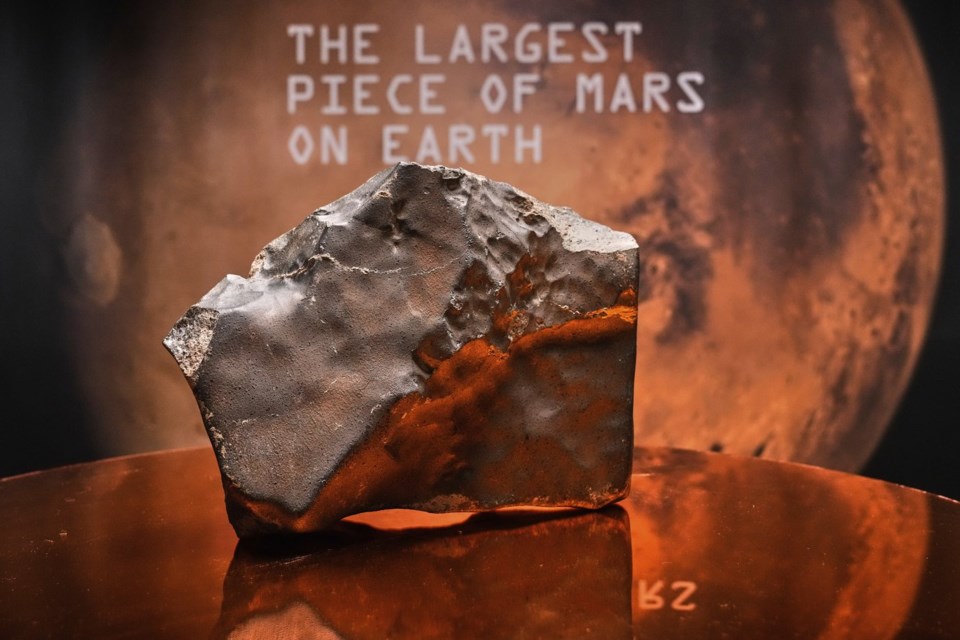The largest piece of Mars ever found on Earth was sold for just over $5 million at an auction of rare geological and archaeological objects in New York on Wednesday. But a rare young dinosaur skeleton stole the show when it fetched more than $30 million in a bidding frenzy.
The 54-pound (25-kilogram) rock named NWA 16788 was discovered in the Sahara Desert in Niger by a meteorite hunter in November 2023, after having been blown off the surface of Mars by a massive asteroid strike and traveling 140 million miles (225 million kilometers) to Earth, according to Sotheby's. The estimated sale price before the auction was $2 million to $4 million.
The identity of the buyer was not immediately disclosed. The final bid was $4.3 million. Adding various fees and costs, the official sale price was about $5.3 million. The live bidding was slow, with the auctioneer trying to coax more offers and decreasing the minimum bid increases.
The dinosaur skeleton, on the other hand, sparked a bidding war. With a pre-auction estimate of $4 million to $6 million, it is one of only four known Ceratosaurus nasicornis skeletons and the only juvenile skeleton of the species, which resembles the Tyrannosaurus rex but is smaller.
Bidding for the skeleton started with a high advance offer of $6 million, then escalated during the live round with bids $500,000 higher than the last and later $1 million higher than the last before ending at $26 million. People applauded after the auctioneer gaveled the bidding closed.
The official sale price was $30.5 million with fees and costs. That buyer also was not immediately disclosed.
Parts of the skeleton were found in 1996 near Laramie, Wyoming, at Bone Cabin Quarry, a gold mine for dinosaur bones. Specialists assembled nearly 140 fossil bones with some sculpted materials to recreate the skeleton and mounted it so it’s ready to exhibit, Sotheby’s says. It was acquired last year by Fossilogic, a Utah-based fossil preparation and mounting company.
It’s more than 6 feet (2 meters) tall and nearly 11 feet (3 meters) long, and is believed to be from the late Jurassic period, about 150 million years ago. Ceratosaurus dinosaurs could grow up to 25 feet (7.6 meters) long, while the T. rex could be 40 feet (12 meters) long.
The bidding for the Mars meteorite began with two advance offers of $1.9 million and $2 million. The live bidding slowly proceeded with increases of $200,000 and $300,000 until $4 million, then continued with $100,000 increases until reaching $4.3 million.
The red, brown and gray meteorite is about 70% larger than the next largest piece of Mars found on Earth and represents nearly 7% of all the Martian material currently on this planet, Sotheby’s says. It measures nearly 15 inches by 11 inches by 6 inches (375 millimeters by 279 millimeters by 152 millimeters).
It was also a rare find. There are only 400 Martian meteorites out of the more than 77,000 officially recognized meteorites found on Earth, the auction house says.
“This Martian meteorite is the largest piece of Mars we have ever found by a long shot,” Cassandra Hatton, vice chairman for science and natural history at Sotheby’s, said in an interview before the auction. “So it’s more than double the size of what we previously thought was the largest piece of Mars.”
It’s not clear exactly when the meteorite was blasted off the surface of Mars, but testing showed it probably happened in recent years, Sotheby's says.
Hatton said a specialized lab examined a small piece of the red planet remnant and confirmed it was from Mars. It was compared with the distinct chemical composition of Martian meteorites discovered during the Viking space probe that landed on Mars in 1976, she said.
The examination found that it is an “olivine-microgabbroic shergottite,” a type of Martian rock formed from the slow cooling of Martian magma. It has a course-grained texture and contains the minerals pyroxene and olivine, Sotheby’s says.
It also has a glassy surface, likely due to the high heat that burned it when it fell through Earth’s atmosphere, Hatton said. “So that was their first clue that this wasn’t just some big rock on the ground,” she said.
The meteorite previously was on exhibit at the Italian Space Agency in Rome. Sotheby’s did not disclose the owner.
Wednesday’s auction was part of Sotheby’s Geek Week 2025 and featured 122 items, including other meteorites, fossils and gem-quality minerals.
Dave Collins, The Associated Press



